By Sean Fagan
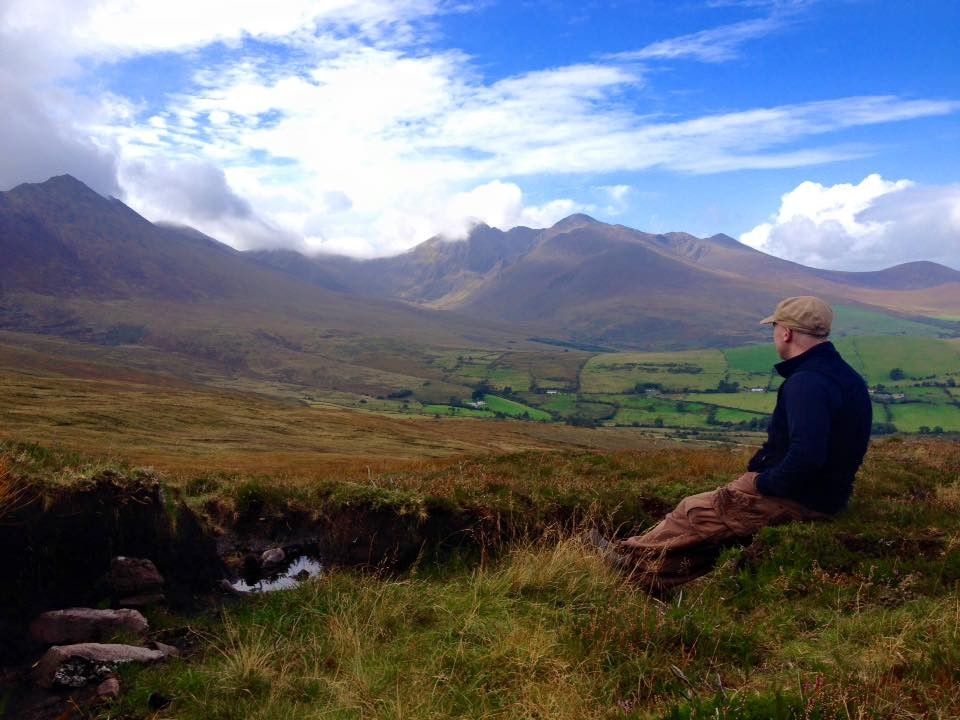
I had a fantastic time hiking around the magnificent mountains of County Kerry while budget-camping. In photo, the famous MacGillicuddy's Reeks mountain range in the distance - what a place! (Photo: Sean Fagan)
.
Recently I went camping in southwest Ireland…accidentally!
Accidentally?
Let me explain.
The plan was to bring my bicycle to county Kerry, southwest Ireland and stay in a hostel.
I wanted to cycle a lot, hike a bit and do some bushcraft throughout the daylight hours of my four-day stay.
All part of my plan to building up the necessary stamina and experience for future bicycle and camping tours.
.
But a problem arose…
The hostel was overbooked.
No rooms left.
Great.
I’ve been going to this hostel for years and never had any problems. Just a simple administrative error.
What was I going to do?
I phoned all the other hostels in town – no rooms left!
Despite it being late in the tourist season there was still a glut of tourists milling around the town.
I was kind of stumped.
.
I hadn’t really considered the other option - hotels.
To be honest, I’m not a big fan of hotels (I much prefer the value for money and communal feel of good hostels - and being able to cook for myself).
.
So I decided there and then to book myself into what I consider the best hotel in the world…nature!
.
I had some bushcraft gear and I knew the surrounding country fairly well - but I didn’t bring any sleeping or shelter kit.
Time for action.
.
What I needed could be broken down into 3 basic needs:
- Something to sleep on
- Something to sleep in
- Something to sleep under
.
*Whenever you are stuck in the outdoors – base your immediate goals on simple, bodily needs such as food, water, shelter, warmth etc.
Keep it real simple.
.
So off I went to an outdoor store that stocked mostly inexpensive items.
After a quick look around I decided on the following 4 items…
.
- Sleeping bag - 20 Euros
- 4 x 5m Tarp – 12.50 Euros
- Inflatable Mattress - 18 Euros
- Roll of string (of good quality, to tie up my tarp) – 6.00 Euros
Total cost: 56.50 Euros
.

My receipt showing the 4 items I purchased for camping. The roll of string, sleeping bag and mattress are listed under tools (Photo: Sean Fagan).
.
I had about 3 hours of light left, so off I went – cycling into the wild yonder like a mad thing on a mission.
It took me over an hour to find a good camping spot (always time well spent).
About 2 hours of light left, and counting…
.
PUTTING UP MY TARP
Creating a home in the woods
.
Always a priority – to put up your shelter first.
I was more than miffed that the smallest tarp size I could purchase was 4 x 5 metres, which is bloody big.
The store had recently sold out their 2 x 3 metre tarps – which would have been ideal and much more manageable to suspend and peg out.
My 4 x 5 metre tarp was an unyielding, flapping-in-the-wind sail of a thing that could have comfortably sheltered a small village of campers (I exaggerate, slightly).
So I quickly tied up a high support-line so I could properly suspend this large, unruly sheet of plastic. I tied the line about 2.5 metres off the ground, between two sturdy trees.
.
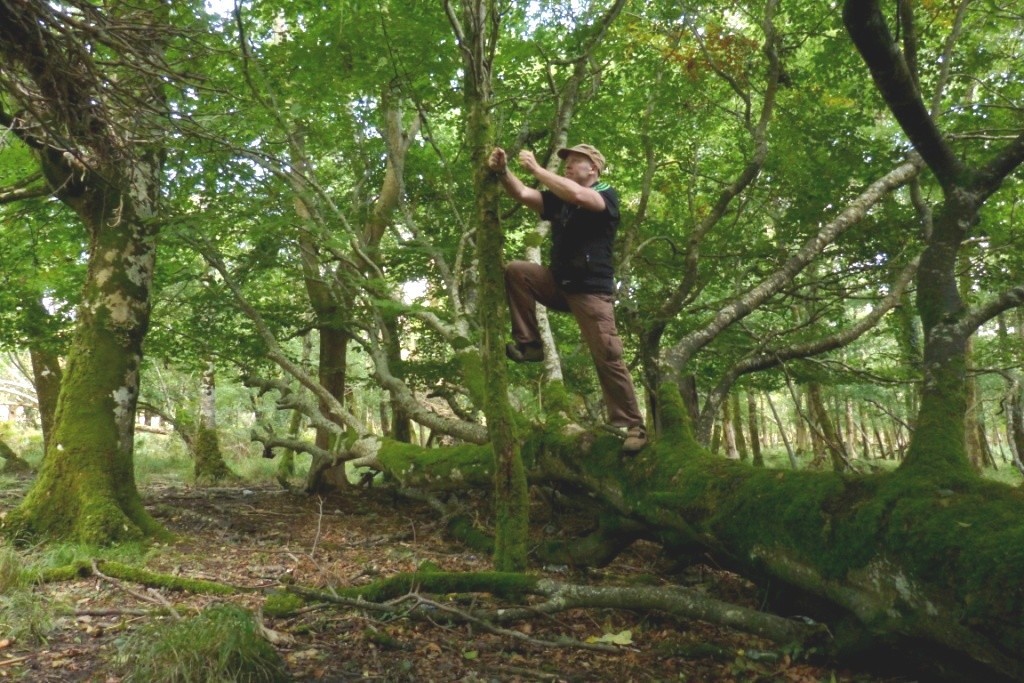
Here I was, tying up a very high line between two trees. It's important that this line is very taut - otherwise the weight of the tarp will cause sagging - causing the tarp to be far less efficient at shedding rain (Photo: Sean Fagan).
.
I went for a simple layout – with one side of the tarp reaching the ground (on the windward side).
Such a layout provides a very welcome respite from the chilling effects of the wind.
Also, when one side of a tarp reaches the ground – it can be anchored down with long, large dead branches (or rocks) found on the woodland floor. No need to carve wooded pegs and stake out the tarp.
.
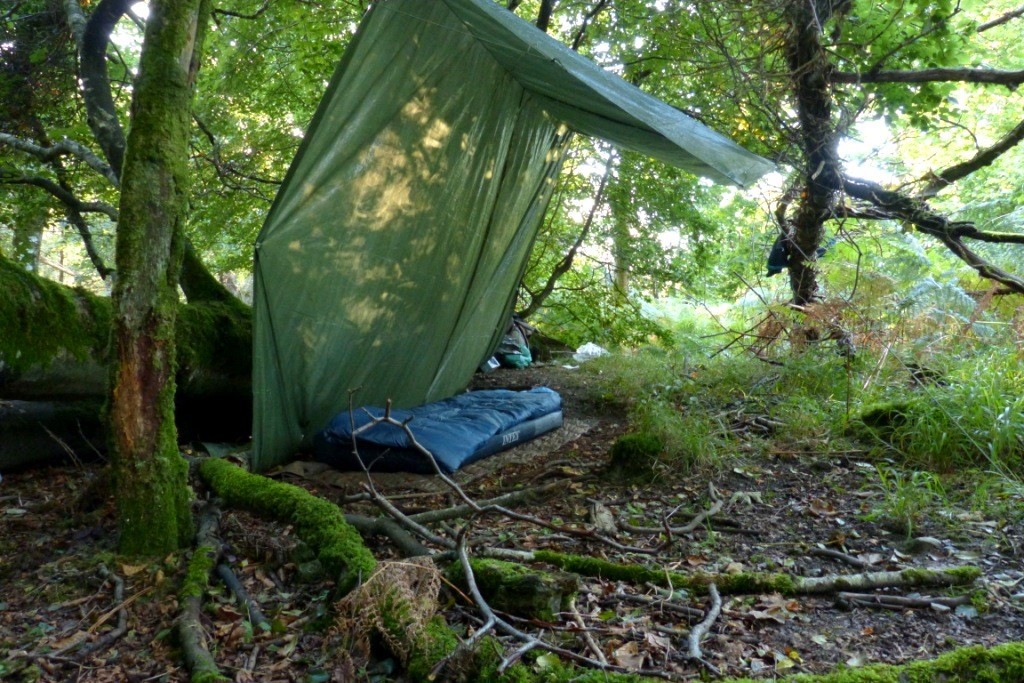
Home sweet home. Might not look like much but it was very effective - and that's what counts. I like this tarp layout, especially with large tarps. The tarp 'wall' was facing southwest - the direction of prevailing winds in southwest Ireland. Note old blanket under mattress (left by a camper). This blanket provided a modicum of puncture-protection for my mattress (Photo: Sean Fagan).
.
The biggest challenge to properly suspending a cheap tarp is to avoid over-straining the grommets.
After all, it’s a cheap tarp which might be passable for general duties around a garden or farm but when exposed to the wild - it can be a fragile item if not properly cared for.
.
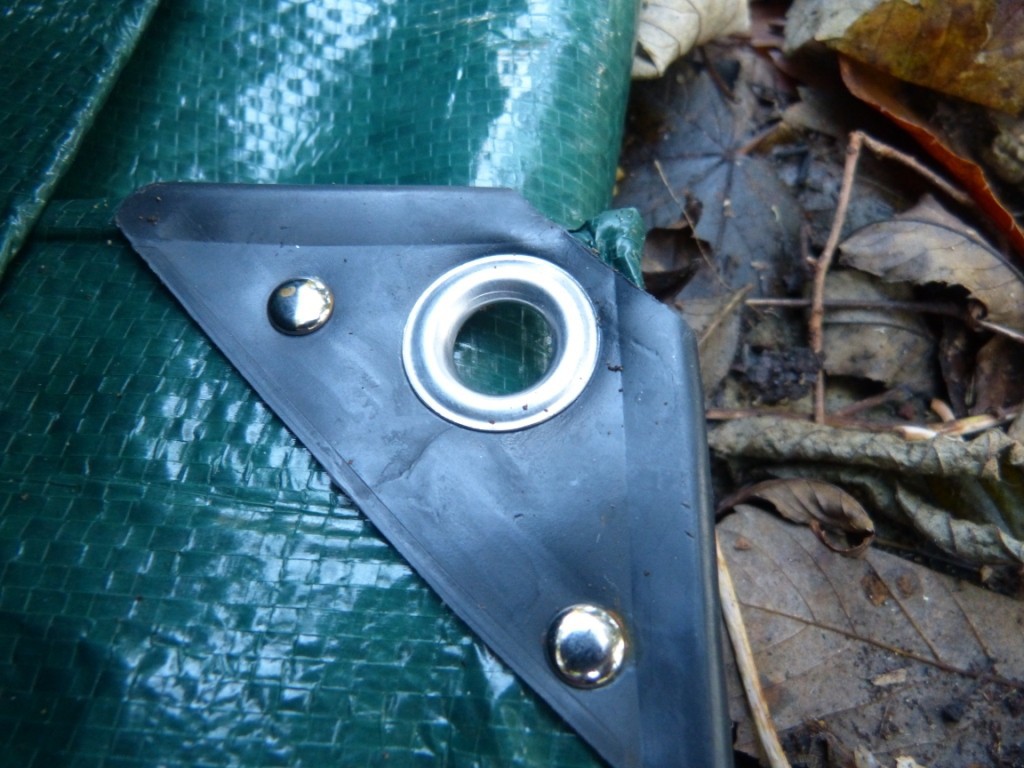
Although the corner grommets of the tarp were reinforced, as in photo, they were not that strong (Photo: Sean Fagan).
.
So I always use adjustable knots when suspending such a cheap tarp. That way I can adjust the tension.
This is important because if it’s windy and the grommets look like they are going to break free then it’s important to lessen the tension to provide relief.
You have to hit that sweet spot between achieving the right tautness (so that the tarp effectively sheds rain) and not suspending the tarp too tautly - because then the grommets are at risk of being pulled free from strong winds.
This is all part of the learning curve as regards knowing the capabilities of materials and outdoor kit.
It’s a subtle skill set that is built over time through experience. A second sense if you will.
.
SLEEPING BAG
Creating a cocoon of warmth
.
My sleeping bag, like my tarp, was cheap.
I didn’t purchase a bivvy bag (the outdoor store had none) so I was potentially susceptible to a cold wind chilling me in my sleeping bag.
My solution was simple. I found some dry, discarded newspapers in town, and stuffed them into my rucksack.
At camp, I balled up each page of the newspaper (loosely, not too tightly).
I threw the balled up pages into my sleeping bag.
They greatly boosted the thermal insulation of my sleeping bag. The paper balls trapped the heat my body was emitting much more effectively within the many tiny, air pockets of balled-up paper. This little trick significantly increased the internal temperature of my sleeping bag (if I was to take a guess, by about 5 degrees centigrade - which is a lot, enough to negate any chilly breezes).
Ironically, I learned about this survival trick from reading a newspaper article years ago, about Russian soldiers serving in Afghanistan. The soldiers would often stuff newspapers into their clothes to keep warm.
I also slept in my socks, shorts, vest and t-shirt. On my head I wore a beanie hat and around my neck, a headover.
.
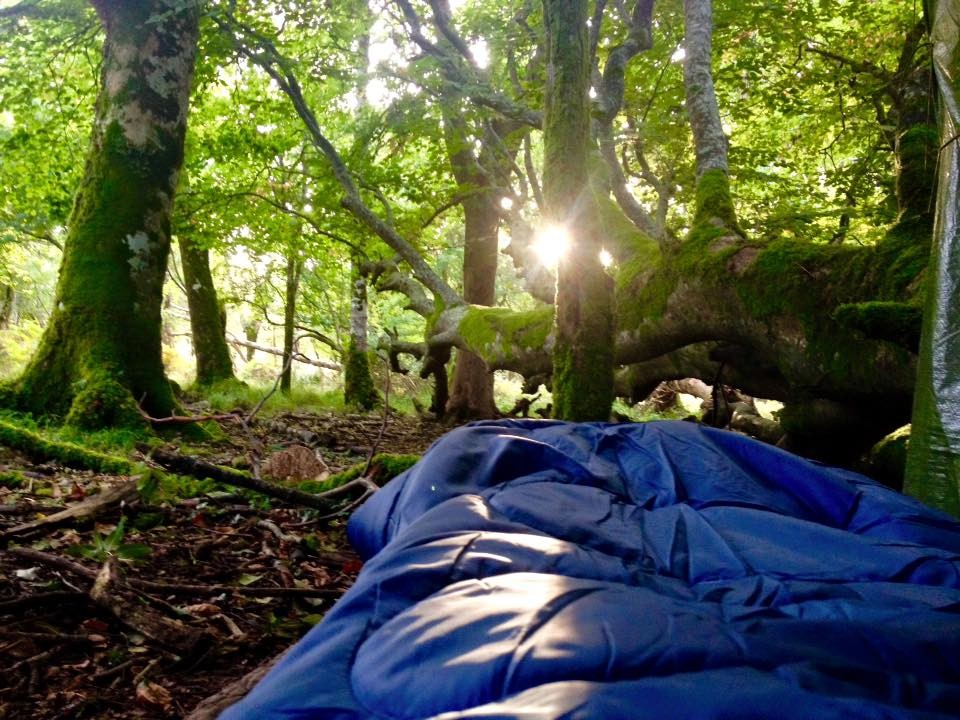
Morning view from my newspaper-stuffed, sleeping bag while camping. Rising sun from the east, birds singing and deer calling - a great way to wake up (generally beats waking up in a hotel in my opinion), (Photo: Sean Fagan).
.
Admittedly, my sleeping bag was susceptible to absorbing dampness during the chilly, damp autumnal days I was camping - but I choose a breezy, elevated camp site - and had deliberately camped away from any land depressions and large bodies of water such as lakes and rivers which naturally accumulate damp air.
Bivvy bags are good for preventing cooling breezes from chilling you in your sleeping bag. They are also good for deterring damp air being absorbed into your sleeping bag. Something to keep in mind when sleeping out in the open during damp, cold weather.
The other solution is simple – sleep in a tent, but I chose a tarp because it’s a much better way of connecting to nature than a tent.
.
MATTRESS
For the love of softness
.
With my mattress I hit gold.
I bought a cheap but very comfortable inflatable mattress.
After much lungful inflating on my behalf – the inflated mattress was about 10 cm thick!
That’s living in luxury.
10cm of cushiony goodness that easily insulated me against the cold, damp soil (I could almost hear my backbone murmuring sweet whispers of gratitude in my ear : ).
I also took plenty of time to clear away all woodland debris under the mattress– just to be sure that my mattress didn't puncture. I also placed an old, discarded blanket (most likely left by a previous camper) under the mattress.
.
Did I sleep well?
Yes, very well.
Warm, dry and comfortable.
.
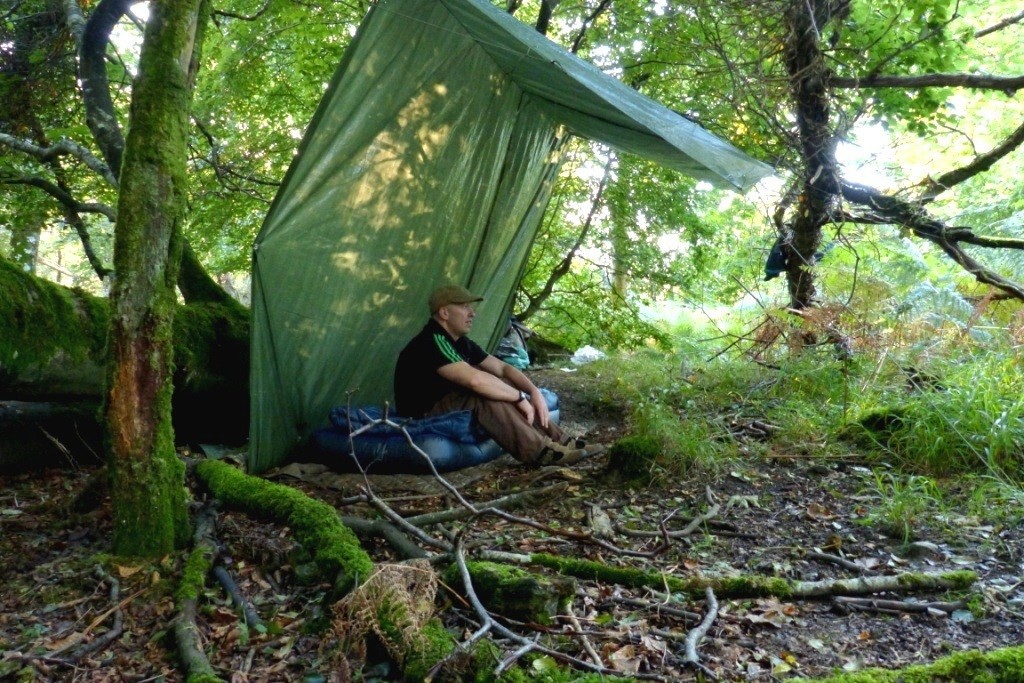
Finally, I could relax a bit. Tarp up, mattress inflated, sleeping bag out and ready. Just in time, as the sun was starting to sink into the west. During the day, I would leave my sleeping bag and spare clothes suspended on the support line under the tarp, to air-dry them. It was nice to come back, after an active day outdoors, to fresh-smelling and dry spare clothes and sleeping bag (Photo: Sean Fagan).
.
My first night passed without incident…until about 4am.
Rain came hard about 4am, pattering noisily on the tarp. It was nice to lie there, dry as a bone, under a cheap tarp I erected myself - and within a cheap sleeping bag I purchased the day before.
About half an hour into the heavy rain a deep bellowing sound stirred the darkness.
The hoarse, rasping roars of a pre-rut, red deer stag was very near – so near, I can hear the sharp inhalations of air into its deep chest - before emitting its loud, guttural calls into the dark night.
Being so close to such an evocative, primal sound was great.
.
At dawn, the distinctive clash of antlers as two stags playfully jousted.
It won’t be long until they are fighting for real (The rut was about 2-3 weeks away).
In the canopy, emerged a red squirrel…passing through.
.
I stayed in this camp for four nights. I also stuck to my original plan and cycled, hiked and did some bushcraft throughout most of the daylight hours I was there.
At camp - rain, high winds, more deer, sunshine, chilliness and mists were my companions for four more beautiful evenings and mornings.
.
This is what bushcraft is for me.
And if it only cost 56.50 euros - count me in.
.
.
.
"I learned how much of what we think to be necessary is superfluous; I learned how few things are essential, and how essential those things really are" ~ Bernard Ferguson
.
.
.
Related articles on this website:
.
Related material:
- What is a Bivvy bag and how to choose one (Alastair Humpreys - Adventurer)
- Deer species of Ireland (including red deer) (The Vincent Wildlife Trust)
- The Irish Elk
..
.
.
Finally, a warning about Red Deer Stags...
.
Don’t mess around with red deer stags in full rutting mode. When rutting, they can become aggressive. I don’t know if I would have camped in that wood full of testosterone-charged stags looking for a fight during the height of the rutting season. I knew the rut started in full swing about 2-3 weeks later and pre-rutting stags are far less aggressive than rutting stags.
A red deer stag can reach a weight of up to 200kgs. Potentially, that's 200kgs of wild-eyed belligerence with antlers. They can do a lot of damage very quickly.
Causalities from red deer stags are incredibly low. Then again, the vast majority of people don’t camp on their patch. Respect them.
If in doubt – camp well away from them.
.
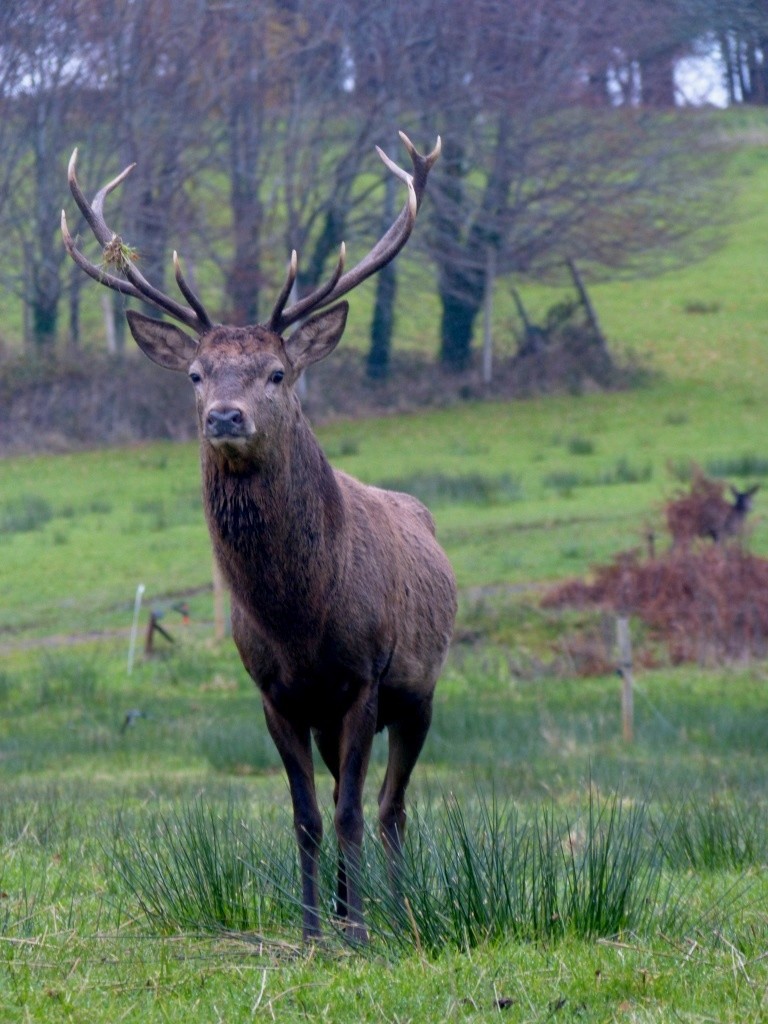
Not to be messed with. Red deer stag photo I took a couple of years ago in County Kerry, southwest Ireland.
.
An incident happened to a guy I knew involving a red deer stag. A rutting stag literally barred his exit from a wood for about 30 minutes. The deer kept aggressively posturing and walking towards him, often slowly pursuing him around the trunk of a large tree.
Eventually the deer lost interest and left.
The guy, a hefty rugby player, was shaken by the experience.
Outside of the rutting season, male red deer are quite wary and generally flee away at the first opportunity from humans.
*Please, if you are one of those people that like to take selfies with wild animals then please read this: Woman knocked down by horny deer after trying to take a selfie.
.
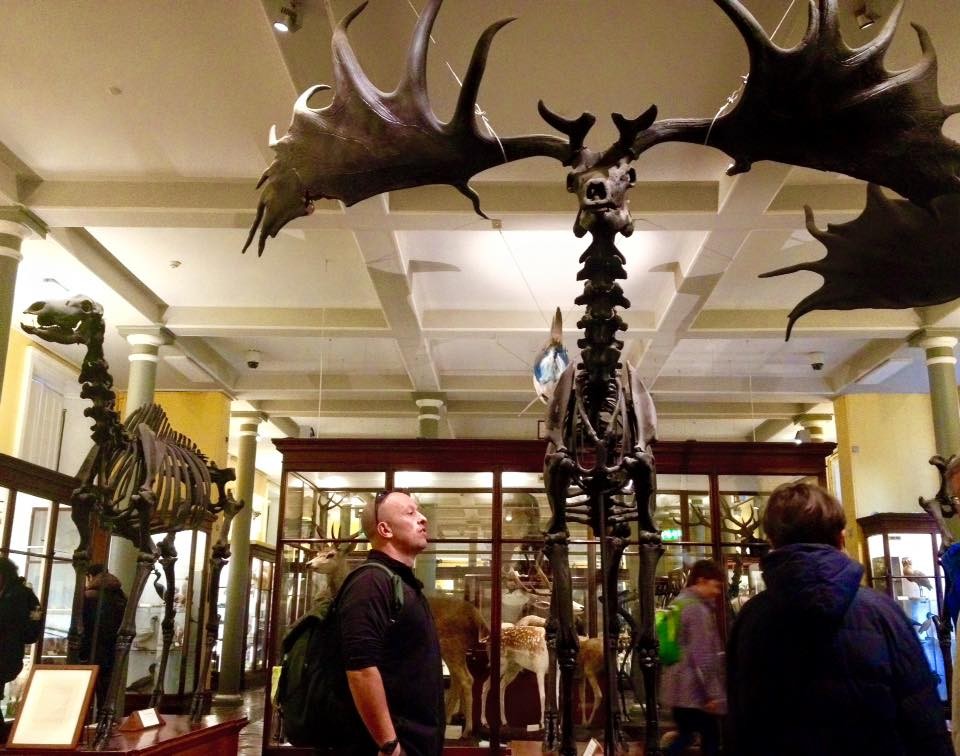
Imagine dealing with one of these on a woodland ramble? Sadly extinct, the Irish Elk (Megaloceros giganteus) was a true behemoth among deer species. Considering a red deer stag can weigh up to 200kgs, the giant elk could reach a staggering weight of 700kg. That's pretty astounding (Photo: Sean Fagan).

Recent Comments